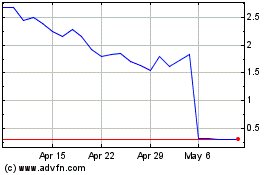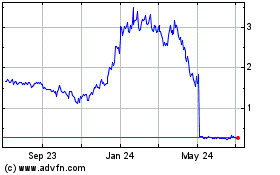GlycoMimetics Presents Updated Data from Ongoing Phase 1/2 Clinical Trial of GMI-1271 in Patients with Acute Myeloid Leukemia...
June 05 2017 - 7:00AM
Business Wire
- Remission rates continue to be higher
than historical controls and induction-related mortality continues
to be lower than historical controls
- GMI-1271 continues to be well tolerated
in combination with induction chemotherapy
- Only one case of severe (Grade 3/4)
mucositis reported among 79 patients receiving high-intensity
induction chemotherapy
- Relapsed/refractory patients with more
blasts expressing the E-Selectin ligand were more likely to achieve
complete response (p value=.004)
- Initial duration of response data is
encouraging
GlycoMimetics, Inc. (NASDAQ:GLYC) today announced new and
updated data from the Phase 2 portion of its ongoing Phase 1/2
clinical trial that showed high remission and low mortality rates
of its drug candidate GMI-1271, an E-selectin antagonist being
developed as a treatment for patients with acute myeloid leukemia
(AML). Clinical investigators are presenting the data today from 79
patients in the trial via posters and discussion at the 2017 annual
meeting of the American Society for Clinical Oncology (ASCO) in
Chicago. In this trial, patients treated with GMI-1271 together
with standard chemotherapy continue to achieve higher than expected
remission rates based on historical controls, as well as lower than
expected induction-related mortality rates. Treatment also
continues to be well tolerated in this patient population.
“We are excited to share this promising new data for GMI-1271,
which continue to support the potential for this new drug candidate
to treat AML, a disease that has often eluded medical interventions
thus far,” said Rachel King, Chief Executive Officer of
GlycoMimetics. “We are increasingly optimistic that GMI-1271 may
help address unmet needs in this and other cancers.”
Among the 54 relapsed/refractory AML patients participating in
the trial for whom data is available:
- The overall response rate (complete
remission/complete remission with incomplete marrow recovery, or
CR/CRi) was 41 percent, which is higher than historical controls,
and the 60-day induction related mortality rate was 7 percent,
which is lower than historical controls.
- Oral mucositis, or inflammation with
mouth ulcers that is a sign of adverse effects of chemotherapy, was
seen at low rates and severity with only one Grade 3/4 event
observed.
- The median overall survival time for
Phase 1 trial patients was 7.6 months.
- Remissions were durable enough to allow
9 patients to receive stem cell transplants.
- For patients in the Phase 1 portion of
the trial who responded with a remission, more than half survived
for at least a year after treatment.
Among the 25 newly diagnosed elderly patients (age 60 and older)
participating in the trial for whom data is available:
- The overall response (CR/CRi) rate was
68 percent, with 73 percent in patients with de novo AML and 64
percent in patients with secondary AML.
- The 60-day mortality rate was 8
percent.
- There were no cases of grade 3 or 4
mucositis.
- For the 9 evaluable patients achieving
CR/CRi, disease-free survival was 100% at 6 months after
treatment.
“These results are very encouraging, indicating that the
E-selectin antagonist may enhance our ability to improve the
complete remission rate and potentially to
improve the tolerability of intensive chemotherapy
for patients with acute myeloid leukemia,” said Daniel J.
DeAngelo, MD, PhD, the trial’s Lead Investigator, who serves
as Dana-Farber Cancer Institute Director of Clinical and
Translational Research, Adult Leukemia, and Institute Physician,
and Associate Professor of Medicine at Harvard Medical School.
“We look forward to continuing our clinical testing of GMI-1271 and
further examining its potential for improving outcomes
for patients with AML.”
The ASCO Annual Meeting is taking place from June 2-5, 2017 at
McCormick Place in Chicago. More detail and the meeting abstracts
are available at ASCO’s website.
Data from the Phase 1/2 trial were submitted to the U.S. Food
and Drug Administration (FDA). In May 2017, the FDA granted
GMI-1271 Breakthrough Therapy designation for treatment of adult
patients with relapsed/refractory AML. In addition, GMI-1271 has
been granted Orphan Drug designation and Fast Track status by the
FDA and Orphan Drug designation by the European Commission.
About GlycoMimetics, Inc.
GlycoMimetics is a clinical-stage biotechnology company
focused on cancer and sickle cell disease. GlycoMimetics’ most
advanced drug candidate, rivipansel, a pan-selectin antagonist, is
being developed for the treatment of vaso-occlusive crisis in
sickle cell disease and is being evaluated in a Phase 3 clinical
trial being conducted by its strategic collaborator,
Pfizer. GlycoMimetics' wholly-owned drug candidate,
GMI-1271, an E-selectin antagonist, is being evaluated in an
ongoing Phase 1/2 clinical trial as a potential treatment for AML
and in a Phase 1 clinical trial in multiple myeloma. The U.S.
FDA recently granted GMI-1271 Breakthrough Therapy designation
for treatment of adult AML patients with relapsed/refractory
disease. GlycoMimetics has also recently initiated a clinical
trial with a third drug candidate, GMI-1359, a combined CXCR4 and
E-selectin antagonist. GlycoMimetics is located
in Rockville, MD in the BioHealth Capital Region.
Learn more at www.glycomimetics.com.
Forward-Looking Statements
This press release contains forward-looking statements regarding
GlycoMimetics' planned activities with respect to the clinical
development of its drug candidate GMI-1271. Actual results may
differ materially from those indicated by such forward-looking
statements as a result of various important factors, including the
availability and timing of data from ongoing clinical trials, the
uncertainties inherent in the completion of ongoing clinical trials
and the initiation of future clinical trials, whether interim
results from a clinical trial will be predictive of the final
results of the trial or results of early clinical trials will be
indicative of the results of future trials, expectations for
regulatory approvals, availability of funding sufficient for
GlycoMimetics' foreseeable and unforeseeable operating expenses and
capital expenditure requirements, other matters that could affect
the availability or commercial potential of GlycoMimetics' drug
candidates and other factors discussed in the "Risk Factors"
section of GlycoMimetics' Annual Report on Form 10-K that was filed
with the U.S. Securities and Exchange
Commission on March 1, 2017, and other
filings GlycoMimetics makes with the Securities and
Exchange Commission from time to time. In addition, the
forward-looking statements included in this press release represent
GlycoMimetics' views as of the date
hereof. GlycoMimetics anticipates that subsequent events
and developments may cause its views to change. However,
while GlycoMimetics may elect to update these
forward-looking statements at some point in the
future, GlycoMimetics specifically disclaims any
obligation to do so, except as may be required by law. These
forward-looking statements should not be relied upon as
representing GlycoMimetics' views as of any date subsequent to the
date hereof.
View source
version on businesswire.com: http://www.businesswire.com/news/home/20170605005304/en/
GlycoMimetics, Inc.Investors:Shari Annes,
650-888-0902sannes@annesassociates.comorMedia:Jamie
Lacey-Moreira, 410-299-3310jamielacey@presscommpr.com
GlycoMimetics (NASDAQ:GLYC)
Historical Stock Chart
From Mar 2024 to Apr 2024

GlycoMimetics (NASDAQ:GLYC)
Historical Stock Chart
From Apr 2023 to Apr 2024
